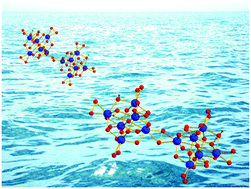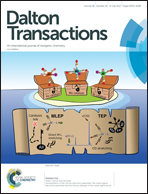Aqueous tantalum polyoxometalate reactivity with peroxide†
Abstract
Peroxide ligation of aqueous metal–oxo clusters provides rich speciation and structural diversity, radiation sensitivity for manipulation with light, and both broadens and shifts pH-range stability. Here we demonstrate peroxide ligation of the polyoxometalate (POM) [Ta6O19]8−. We study in detail solution speciation of the peroxide-substituted cluster, and benchmark it to the peroxide-ligated niobate analogue, [Nb6O10(OH)3(O2)6]5−, whose solid-state structure has been reported. Raman and electrospray ionization mass spectroscopy do not detect any significant differences between the two analogues. However, small and wide-angle and total X-ray scattering strongly indicate that peroxide promotes linking of the hexameric tantalate clusters, rather than terminating and capping the clusters, as observed for the niobate analogue. We used computational studies to identify Raman peak positions, determine the energetics of exchange of oxo-ligands for peroxo-ligands, and provide models to help explain the X-ray scattering data. Understanding the solution speciation of peroxide-substituted polyoxotantalates is an important step towards its use in solution processed thin film materials, as well as developing new Ta-POM chemistry.



 Please wait while we load your content...
Please wait while we load your content...